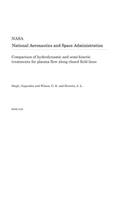
Comparison of Hydrodynamic and Semi-Kinetic Treatments for Plasma Flow Along Closed Field Lines
Series:
Hydrodynamic and semi-kinetic treatments of plasma flow along closed geomagnetic field lines are compared. The hydrodynamic treatment is based on a simplified 16-moment set of transport equations as the equations for the heat flows are not solved; the heat flows are treated heuristically. The semi-kinetic treatment is based on a particle code. The comparison deals with the distributions of the pla
NaN
VOLUME
English
Paperback

Hydrodynamic and semi-kinetic treatments of plasma flow along closed geomagnetic field lines are compared. The hydrodynamic treatment is based on a simplified 16-moment set of transport equations as the equations for the heat flows are not solved; the heat flows are treated heuristically. The semi-kinetic treatment is based on a particle code. The comparison deals with the distributions of the plasma density, flow velocity, and parallel and perpendicular temperatures as obtained from the two treatments during the various stages of the flow. In the kinetic treatment, the appropriate boundary condition is the prescription of the velocity distribution functions for the particles entering the flux tubes at the ionospheric boundaries; those particles leaving the system are determined by the processes occurring in the flux tube. The prescribed distributions are half-Maxwellian with temperature T(sub 0) and density n(sub 0). In the hydrodynamic model, the prescribed boundary conditions are on density (n(sub 0)), flow velocity (V(sub 0)) and temperature (T(sub 0). It was found that results from the hydrodynamic treatment critically depend on V(sub 0); for early stages of the flow this treatment yields results in good agreement with those from the kinetic treatment, when V(sub 0) = square root of (kT(sub 0)/2 (pi)m), which is the average velocity of particles moving in a given direction for a Maxwellian distribution. During this early stage, the flows developing form the conjugate ionospheres show some distinct transitions. For the first hour or so, the flows are highly supersonic and penetrate deep into the opposite hemispheres, and both hydrodynamics and kinetic treatments yield almost similar features. It is found that during this period heatflow effects are negligibly small. When a flow penetrates deep into the opposite hemisphere, the kinetic treatment predicts reflection and setting up of counterstreaming. In contrast, the hydrodynamic treatment yields a shock in the f...
Price Comparison [India]
In This Series
Bestseller Manga
Trending NEWS




















